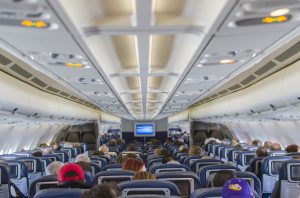 Whether you’re flying in a massive Airbus A380 or a smaller regional jet (RJ), it probably has a pressurized cabin. With the exception of certain military aircraft, all airplanes have a pressurized cabin. It’s an integral part of designing an aircraft. So, what’s the purpose of a pressurized cabin exactly?
Whether you’re flying in a massive Airbus A380 or a smaller regional jet (RJ), it probably has a pressurized cabin. With the exception of certain military aircraft, all airplanes have a pressurized cabin. It’s an integral part of designing an aircraft. So, what’s the purpose of a pressurized cabin exactly?
How Cabins Are Pressurized
Airplane cabins are pressurized by forcing air into the cabin. Just like you pressurize a car tire by flowing air into it, airplanes do the same for the cabin. Air is pumped into the cabin, and because the cabin is sealed, the pressure increases. Normally, this pressure is created from the engines used to power the airplane. As the engines turn fuel and generate combustion, some of the air is forced into the cabin (don’t worry; it’s clean) to achieve an appropriate pressure.
Why Pressurized Cabins Are Necessary
Cabins are pressurized to create a safe and comfortable environment for pilots, crew and passengers. Most commercial airplanes fly at around 30,000 to 40,000 feet above sea level. At high altitudes such as this, the air is thinner than it is on the ground. And being that humans have evolved on land, our lungs are designed to breathe this thin air. If someone is forced to breathe the air at 30,000 feet, he or she may experience a medical condition known as hypoxia, which is characterized by lack of oxygen to the brain. By pressurizing the cabin, however, it creates a suitable environment with more oxygen, which is essential for our health and wellness.
The use a pressurized cabin is essential for creating a safe environment for passengers, but it does carry the risk of a blowout. If a window breaks or emergency door opens, everything will be sucked out as the pressure attempts to equalize. The highly pressurized air inside the cabin will travel outside of the airplane where the pressure is much lower.
Some people assume that only the cabin of an airplane is pressurized, but this isn’t necessarily true. In many cases, the entire fuselage is pressurized, including the cargo hold. This means all checked luggage and other cargo the plane is carrying is under the same pressure.
To recap, airplanes are pressurized because it protects pilot, crew and passengers from hypoxia. Airplanes are designed to pump air into the cabin to mimic the 14.7 pounds per square (PSI) of pressure that’s found at sea level.



